
Back
If you ever have the opportunity to go to Black Rock, jump on it! Its the best place I have ever been to for flying rockets. Thanks to the AESS guys for letting us tag along in their caravan, and thanks to my brother Brad, for driving his truck, and getting it all covered with Black Rock dust.
Click on any picture for a larger view
Day 0
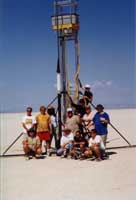 |
| The Portland State AESS team was kind enough to let us caravan with them. |
Driving. Lots of driving. We (My brother and I) left Bonney Lake at about 3am, heading for Portland where we were going to meet up with the AESS guys and caravan to Black Rock.
The plan was to leave Portland at 6am, but we didnt get out until about 8am.
We drove all day, and got bogged down in a bunch of construction heading over the mountains, but finally made it to Black Rock around 8pm that night.
We drove out onto the Playa lit by a distant lightning storm and proceeded to drive over what seemed like an endless expanse of dust and clay.
What an experience that was! Driving across the Playa in the dark at about 70 mph, headlights creating the illusion you are about to drive off the edge of a cliff.
Its even better with your headlights off. Once we found the flight line we took position at the far east end and set up camp.
In the distance, about a 1/2 mile north of us we could see a large lighted flight tower, an RV, and a large Ryder truck. Some of the AESS guys went over to check it out and came back rather excited.
There was a company setting up a very large hybrid rocket. It was about 10" in diameter, approx 30' tall, built with machined aluminum.
The numbers I heard were something like 200,000 NS, 20 second burn time, estimated altitude 100,000 feet. Wow.
I went out to check it out myself, and walked into a conversation where one of the people working on the rocket was answering questions.
It was some sort of proof-of-concept rocket, and he said they had static tested the motor numerous times, and now wanted to flight test it.
He said they were very light on electronics, were basically motor people, and the rocket's main purpose was to prove the motor design, nothing else.
They were planning on flying it at 8am the next morning.
Day 1
I stumbled out of the camper at about 8 am.
It took my brain a few minutes to get oriented, I've never stood in such a huge expanse of nothing!
What a perfect place to fly rockets! The weather was perfect, no wind, no clouds.
We expected to see the large Hybrid go up, but word came out that they were not ready, and were planning on launching the next morning.
My buddy Clay Clawson rolled in around 9am, having made the drive from Utah all night, and we made the rounds through all the vendors.
Clay picked up a single use Aerotech 54mm J125 which has a 10 second burn, from a local dealer.
I spent all my money (motor money, food money, gas money, range fee's....I'm hopeless) on a Kosdon 54mm 2550NS case and an L-1200 'Green Gorrilla' load for it.
This would be my biggest motor flown to date.
Clay was only going to be able to stay for the first day, so we decided to concentrate on getting his rockets in the air, and I would fly my own stuff the next day.
First up was Clay's PML Quantum Leap, a 2 stage rocket with a 3" diameter airframe.
We decided to use a DPS 54mm K-800 Diamondback load that I had made up a few days earlier for the booster, and the J125 he picked up for the sustainer.
He ran some sims on his laptop, and the estimated altitude was about 10,000 feet!
 |
| Clay Clawson stands ready to send his QL into the great blue yonder |
After about an hour of prep time, his 2 stager was ready to go! We carried it out to the pads, turned in the flight card, and loaded it up.
(The turnout at the launch seemed to be a little light, I was told it was a little slow compared to other launches, probably because of the Aeropac launch that was held the previous week.)
Once we were back at the flight line, the LCO announced Clay's rocket, ran the countdown, and hit the button.
The K-800 came right up to pressure and KICKED the Quantum Leap into the air.
Then things got ufgly.
The rocket arched badly to the north, and the second stage lit too late.
By the time the J125 came up to pressure, the rocket was at nearly a 30 degree angle, and flew out of sight down the playa.
Later examination of video footage confirmed that the delay from booster burnout to sustainer ignition was too long, but also, the rocket actually flexed at the booster to sustainer joint under the thrust of the K-800. Mean motor!
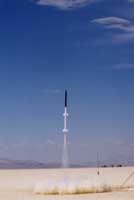 |
| The Quantum Leap boosts quickly on the DPS K-800 |
The booster was recovered a few hundred yards north of the pad, the chute stripped. Damage to the airframe was moderate to severe.
The sustainer was never found. We spent several hours driving all over the playa, and all the way to the north end, but to no avail.
A few days later my brother and I zig zagged some more, and found the mylar streamer that was part of the sustainer's recovery system, but nothing more.
If you find a white and navy blue Quantum Leap sustainer in the Black Rock desert, please let us know!
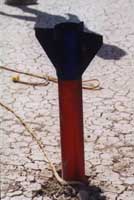 |
| Good thing nobody was on the recieving end of this... |
After returning to camp, we were pondering what to fly next when the LCO announced the flight of one of those Dr Rocket 4" motor and fin can specials.
It consists of the N2000 4" motor casing with a machined aluminum fin can, fiberglass recovery system bay, and machined aluminum nose cone.
The rocket was launched, and boosted beutifully.
We turned back to our own rockets, but then heard a strange sound, almost as loud as the launch of the N2000.
We turned back to the flight line, just in time to see the booster of the rocket come in ballistic and impact in between us and the Hybrid setup about a half mile out.
The sound of the rocket coming in was amazing, kinda scary.
It had suffered some sort of recovery system problem, and the booster had snapped its tubular Kevlar shock cord and come in ballistic.
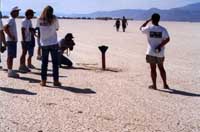 |
| An N2000 with fins came in ballistic, screaming all the way. |
Next, we bumped into Stu Barrett, our local TAP advisor. He was prepping his 5" fiberglass airframe rocket named 'Grand Shot'.
He was getting ready to fly it on one of the new Aerotech 4" Blue Thunder motors, the M2500(?).
I helped him carry it to the rail, and it was ready to go.
The flight was perfect.
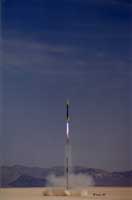 |
| Stu Barrett's 'Grand Shot' on a 4" Blue Thunder M |
The monster Blue Thunder motor boosted the rocket VERY quickly over a blue flame as long as the rocket itself!
The drouge 'chute deployed at apogee, the rocket came down to 500' and the main deployed, but was somewhat tangled.
Once it was down, we jumpted into Stu's truck and drove out to recover the rocket.
It landed hard under the tangled 'chute but sustained no damage.
Gotta luv fiberglass airframes!
As Stu collected the rocket, he checked the altimiter, which beeped out 17,000 feet! Nice Flight!
 |
| Where NOT to be when in Black Rock |
After a great day of flying, Clay had to jump back into his car and drive back home.
He was planning on staying both days, but some last minute network problems at work had made him late, and forced him to return early.
We escorted him back to Gerlach, but had a few problems.
We missed the exit from the Playa and ended up at the south edge where the clay is wet, and he got stuck!
What a mess. It took 3 of us to push the car back onto the dry clay, after stopping twice to pull clay from the wheelwells which were jamming the tires.
The wet clay is like cement. If you go to Black Rock, be sure to steer clear of the wet areas.
That night we had some nice thunderstorms in the distance, and the winds kicked up pretty good. Fortunately, none of the rain came onto the playa.
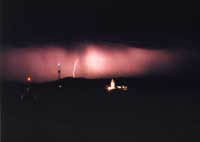 |
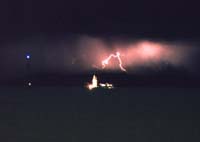 |
| We had some lightning storms in the distance that night. Lit in the foreground is the large Hybrid project. |
Day 2
 |
| The large hybrid project was fueled on the tower, but didnt make it up yet. |
Sunday began just like Saturday.
Perfect weather, and no Hybrid launch.
They got it fueled up, and fired it up, but had some sort of ignition failure, so had to set up again.
They were going to try again in the afternoon.
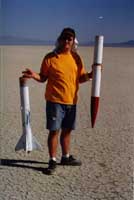 |
| My first flight went off without a hitch. |
As soon as the flying started, I got the Megaroc ready to fly on my remaining DPS K-800 Diamondback.
The same motor that Clay's Quantum Leap had boosted on the previous day.
I set it up, carried it out, and launched. The flight was perfect, a very fast boost.
Both the main and drouge chute deployed at apogee, so it took a while to come down, but there was no wind, and the rocket landed about a half mile away, in plain view.
We drove out to recover it and I popped it open to see what the max altitude was.
To my surprise, the Olsen altimiter was blank!
What had happened was the extreme G forces of the launch apparently pulled the LCD screen on the altimiter partially out of its socket, and when I plugged it back in, the alitimiter reset.
Its an older M1, not the newer recording M2, so the flight data was lost.
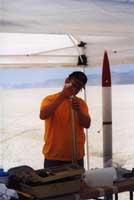 |
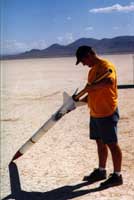 |
| Assembling the L-1200, note the 6" grains. |
Installing the REALLY long L-1200 into the Megaroc. |
I had just recieved a new M2 altimiter, so I decided to swap them out.
I prepped the rocket again, and then brought out the big guns.
The Kosdon 2550NS case is huge, about 29" long.
The reload consisted of 4 grains, each about 6" long. What a beast.
Once prepped, I brought it out to the flight line, and then to the pads.
The LCO ran the countdown, hit the button, and WHAM!
Nice big green flame, and the Megaroc seemed to dissapear.
It was moving very quickly, and all of a sudden did a funky slide to the side maneuver, and then continued upwards.
At first, I hoped all was OK, but then spotted the nosecone falling on its own, as the rest of the rocket proceeded upwards.
 |
| The Megaroc launches on the L-1200. |
We recovered lots of small pieces, and a few big ones, including the booster.
Post mortem examination showed that the airframe kinked at its weakest point, and when it did, the top part of the rocket was torn off and the rest continued up.
The flight data from the M2 is a little weird. It shows 8412 feet max altitude (possible) and 12,000 fps max speed (not possible).
Further examination of the flight data is in process.
It is a sad end, but a worthy one. At least the Megaroc died with honor, under power of a large motor, rather than at the hands of a failed or ballistic recovery.
Later Paul Robinson expained it all to me.
The real reason the Megaroc died is because of a serious incompatablility of the rocket and the motor.
"Thats what you get for flying a Jerry Ervine kit with a Kosdon Motor". :)
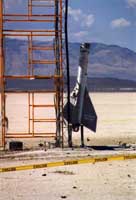 |
| The base of the large aluminum rocket remained on the tower. |
While we were in the camper going over the flight data, we heard a large THUMP!
I jumped out of the trailer, and saw smoke over the Hybrid tower.
Apparently they had attempted to launch (Gee, thanks for the warning...) but suffered some sort of failure.
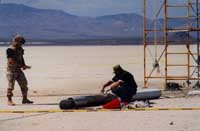 |
| The large Hybrid project suffered a major setback. |
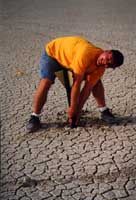 |
| This rocket wasnt going to leave the playa without a fight. |
Since we had no more rockets to fly, we decided to make one more trip up the playa to try and find Clay's rocket.
We zig-zagged around for a couple of hours, but found nothing more than a mylar streamer that was part of the sustainer's recovery system.
We also came across a lot of litter, several very old and corroded 3" artillery rounds (probably live rounds from WWII gun testing done on the Playa long ago, we left them alone), and several tires.
We gave up, and headed back towards camp at about 90 MPH.
I was driving, and all of a sudden my brother yells "HEY WAIT STOP!!"
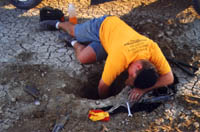 |
| After the protuding airframe came out, there were still many pieces left in the ground. |
We circled around, and there, sticking in the ground, is a rocket.
I tried to pull it out, but it is stuck in hard, so we make note of our position, and head back to camp for a shovel.
With the shovel, I am able to dig it out.
About 4 feet of the rocket is intact, but the rest of the airframe is crumpled and splintered (man, carbon fiber splinters suck).
The solid wood nosecone was pushed aside as the airframe core sampled 3-4 feet into the hard clay.
As I dug out the pieces by hand I was able to make out at least 2 distinct circuit boards.
Then the parachute, still wrapped up, and a few more scraps.
That night we were the last ones on the playa. We started up a camp fire, and tried to entertain ourselves.
Among burning things and attempting to blow stuff up improvising with what we had on hand (yes, there was no shortage of pyro's), we came up with a pretty interesting project.
There were a few chemlights being tossed around (plastic tubes that you bend and shake to mix their contents which then glow for a few hours) and one got tied onto a kite and flown up to about 1000 feet.
Pretty strange site, looked like a green star moving around in the sky.
Then we got the idea to tie another chemlight on a paper towel tube, and put it over the kite string.
We then tied a small Black Powder motor (Esties A8-3) to the tube, and shot it up the kite string.
It worked suprisingly well, and made a nice little green streak across the sky.
Then we got ambitious, and CHAD staged 4 1/2 A motors.
The 4 stage 'rocket' flew right up the kite string, burning all 4 stages, and hit the kite, then zipped back down the string back to us.
Pretty funny.
Its amazing the things you come up with to do when a bunch of rocket geeks get together in the middle of nowhere.
Day 4
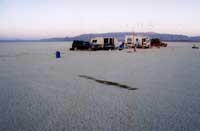 |
| Our group was the last to leave the launch site. |
Another perfect day. Perfect for flying, but we had some driving to do.
We were the last ones leaving the Balls launch site.
We said our farewells, and went our separate ways home.
After about 14 hours of driving I arrived home.
I cant wait to go back.
Back

Rocketry | Experimental | Webhosting | Email | Links | Home
Copyright 1998-2014 Greg Deputy - All Rights Reserved
|